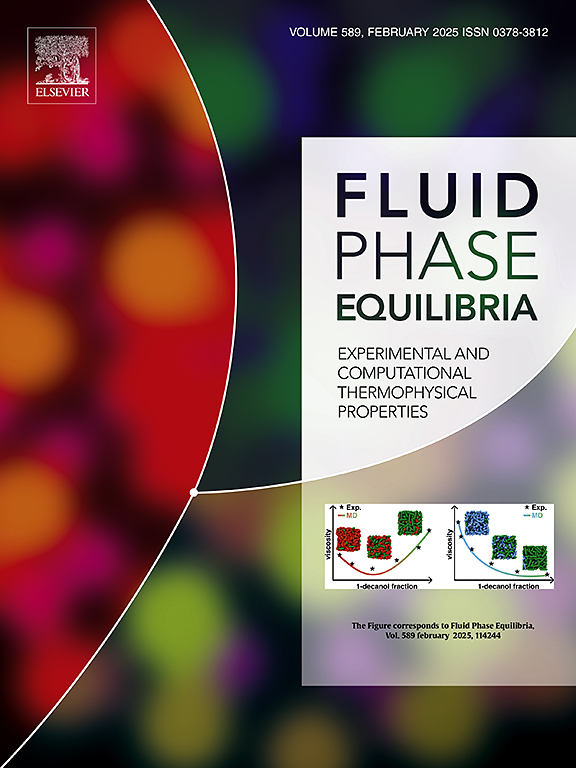Phase equilibria and guest gas occupancy characteristics of H2-DIOX sII hydrates based on calorimetric and Raman analysis
IF 2.8
3区 工程技术
Q3 CHEMISTRY, PHYSICAL
引用次数: 0
Abstract
Hydrogen (H2) as the most abundant element offers a clean energy solution for a sustainable future. Thermodynamic hydrate promoters can enhance hydrate-based H2 storage under mild pressure conditions. 1,3-dioxolane (DIOX) as a low-toxicity promoter has attracted attention for its potential to improve H2 hydrate kinetics. However, the phase equilibria of H2-DIOX in the presence of DIOX and its thermodynamic promotion mechanism are not fully elaborated and warrant thorough investigation. In this study, the phase equilibria of H2-DIOX hydrates were measured for DIOX concentrations (CDIOX) ranging from 2.0 mol% to 5.56 mol%. The equilibrium temperature of H2-DIOX hydrates shifted rightward by 2.3 K at 15.0 MPa for 5.56 mol% DIOX compared to 2.0 mol% DIOX. The measured thermodynamic data were validated by fitting the H2-DIOX hydrate phase equilibira using the Clausius–Clapeyron equation. The cage occupancy of H2 and DIOX in H2-DIOX sII hydrates was revealed through Raman spectroscopy and DSC thermal analysis. Two types of hydrates (DIOX and H2-DIOX) were observed for all CDIOX. Single H2 molecules were enclathrated in the 512 cages of H2-DIOX hydrates and increasing CDIOX effectively enhanced DIOX molecules enclathration in the 51264 cages but had limited effect on the H2 molecules in the 512 cages. The findings of this study provide fundametnal thermodynamic data and cage occupancy charateristics for H2-DIOX sII hydrates below 15.0 MPa. The results provide guidance on the optimal thermodynamic promoter concentrations for future large-scale hydrate-based H2 storage application.
基于量热和拉曼分析的 H2-DIOX sII 水合物的相平衡和客气占位特征
氢(H2)作为最丰富的元素,为可持续发展的未来提供了清洁能源解决方案。热力学水合物促进剂可以在温和的压力条件下提高基于水合物的 H2 储存。1,3-二氧戊环(DIOX)作为一种低毒性促进剂,因其改善 H2 水合物动力学的潜力而备受关注。然而,H2-DIOX 在 DIOX 存在下的相平衡及其热力学促进机制尚未得到充分阐述,需要进行深入研究。本研究测量了 DIOX 浓度(CDIOX)从 2.0 摩尔% 到 5.56 摩尔% 时 H2-DIOX 水合物的相平衡。与 2.0 摩尔% 的 DIOX 相比,5.56 摩尔% 的 DIOX 在 15.0 兆帕时的 H2-DIOX 水合物平衡温度向右移动了 2.3 K。通过使用克劳修斯-克拉皮隆方程拟合 H2-DIOX 水合物相平衡,验证了测得的热力学数据。拉曼光谱和 DSC 热分析揭示了 H2-DIOX sII 水合物中 H2 和 DIOX 的笼占位。在所有 CDIOX 中都观察到了两种水合物(DIOX 和 H2-DIOX)。单个 H2 分子在 H2-DIOX 水合物的 512 个笼子中包层,增加 CDIOX 能有效增强 DIOX 分子在 51264 个笼子中的包层,但对 512 个笼子中的 H2 分子影响有限。本研究结果提供了 15.0 兆帕以下 H2-DIOX sII 水合物的基本热力学数据和笼占位特征。研究结果为未来基于水合物的大规模 H2 储存应用提供了最佳热力学促进剂浓度的指导。
本文章由计算机程序翻译,如有差异,请以英文原文为准。
求助全文
约1分钟内获得全文
求助全文
来源期刊

Fluid Phase Equilibria
工程技术-工程:化工
CiteScore
5.30
自引率
15.40%
发文量
223
审稿时长
53 days
期刊介绍:
Fluid Phase Equilibria publishes high-quality papers dealing with experimental, theoretical, and applied research related to equilibrium and transport properties of fluids, solids, and interfaces. Subjects of interest include physical/phase and chemical equilibria; equilibrium and nonequilibrium thermophysical properties; fundamental thermodynamic relations; and stability. The systems central to the journal include pure substances and mixtures of organic and inorganic materials, including polymers, biochemicals, and surfactants with sufficient characterization of composition and purity for the results to be reproduced. Alloys are of interest only when thermodynamic studies are included, purely material studies will not be considered. In all cases, authors are expected to provide physical or chemical interpretations of the results.
Experimental research can include measurements under all conditions of temperature, pressure, and composition, including critical and supercritical. Measurements are to be associated with systems and conditions of fundamental or applied interest, and may not be only a collection of routine data, such as physical property or solubility measurements at limited pressures and temperatures close to ambient, or surfactant studies focussed strictly on micellisation or micelle structure. Papers reporting common data must be accompanied by new physical insights and/or contemporary or new theory or techniques.
 求助内容:
求助内容: 应助结果提醒方式:
应助结果提醒方式:


